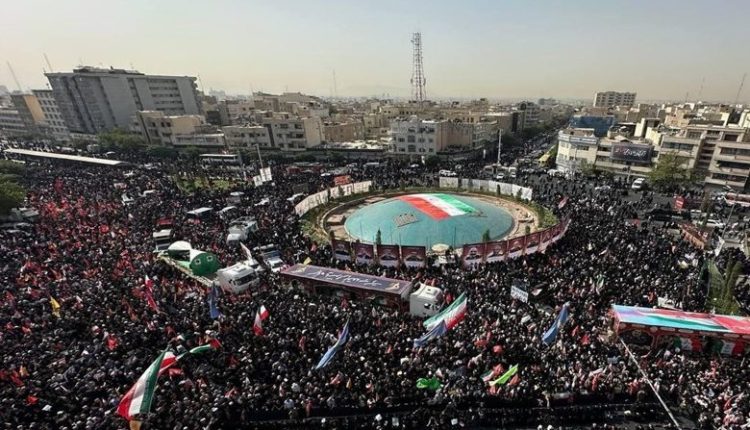Tehran Holds Firm to Its Promise… Funeral of Victims of Zionist Aggression Renews the March of Resistance and Affirms the Nation’s Resolve
قال ChatGPT:
This morning in Tehran, a majestic and mass funeral procession was held for the bodies of more than sixty martyrs—resistance leaders, nuclear scientists, women, and children—who fell during the recent American-backed Zionist aggression. The ceremonies began at Revolution Square (Enghelab) and made their way to Liberty Square (Azadi), conveying a clear message: the nation will not retreat in the face of challenges and assaults, and the blood of the martyrs fuels the ongoing journey of resistance.
Broad Popular Participation and Unprecedented National Solidarity
Hundreds of thousands of Iranians from all segments of society filled the squares, carrying banners reading “Labayk Ya Husayn” and chanting anti-Zionist and anti-American slogans—underscoring a unified national stance against aggression and conspiracy.
In a pre-funeral press conference, Brigadier General Hassan Hassanzadeh, commander of the “Muhammad Rasulullah (PBUH) Corps” of the Revolutionary Guard in Tehran, stated that this turnout is part of the “True Promise” operations, embodying the Iranian people’s determination to defend the nation and stand united against aggression.
He noted that the participation of diverse social groups—especially youth, women, and children—alongside the Muharram mourning processions, added special solemnity to the ceremonies and reflected the people’s cohesion with the leadership and their resolve to persevere in the face of aggression.
Resistance Leaders at the Forefront
The procession prominently included the coffins of senior military commanders and nuclear scientists, accompanied by their families and delegations from various security, military, and Revolutionary Guard branches. This broadened the national character of the event and strengthened the message delivered to the enemy and its instruments.
Member of Parliament Hamid Rasaei affirmed that the million-strong turnout proves the revolution belongs to all its children and that the martyrdom of the country’s leaders and scientists will not halt the nation’s progress.
Rasaei also declared that Iran will take firm action against the International Atomic Energy Agency, accusing it of biased monitoring and acting in favor of the enemies rather than performing its oversight role impartially.
Clear Messages to the Enemy and Its Tools
Ayatollah Ali Reza Salimi, Tehran’s deputy in the Islamic Consultative Assembly, stressed that the popular participation in the funeral sends a clear warning to adversaries: the Iranian people are united and steadfast in defending the revolution and national security. He added that the funeral is not merely a farewell to the martyrs but a proclamation of continued resilience and strength against all attempts to dismantle the system.
Similarly, National Security Committee Chairman Ebrahim Azizi stated that the Iranian people never submit to their enemies; rather, they are the ones who force their adversaries to submit to their resolute will.
He pointed out that the recent sacrifices took place under the Supreme Leader’s guidance to never surrender, enabling the nation to achieve deterrence in just twelve days of confrontation.
Admiral Ali Shamkhani, the Supreme Leader’s political adviser—attending the funeral publicly for the first time since being wounded in the Israeli aggression on Iran—symbolized the depth of national unity and readiness to continue the path of resistance.
A Strong Iranian Stance in Confronting Aggression
These historic ceremonies underscore the Iranian people’s solidarity and preparedness to face new challenges, following the direct Zionist aggression—backed by the United States—launched on 13 June, which lasted twelve days and struck military and nuclear sites as well as civilian installations and personnel.
In retaliation, Iran’s armed forces conducted missile and drone strikes under “True Promise 3,” targeting strategic sites in the occupied Palestinian territories and the U.S. al-Udeid base in Qatar. These actions disrupted American–Zionist plans and established new rules of deterrence in the region.
Political and Field Analysis
Political analyst Saleh Al-Qazwini views these ceremonies not just as farewells but as a powerful reaffirmation of the covenant with the resistance and national defense. He argues that Iran’s response to the American–Zionist aggression exposed miscalculations in Washington and Tel Aviv and thwarted their goals of weakening Iran’s national cohesion.
Al-Qazwini noted that the enemy’s acceptance of a ceasefire, alongside contradictory U.S. statements on sanctions and Iranian oil sales, reveals pronounced confusion and highlights Iran’s robust deterrence capability and the people’s resolve against pressure.
He concluded that Iran is now setting new norms for confronting threats and that the internal political and popular cohesion forms a solid front protecting the revolution and the future of the Resistance axis.
The Martyrs’ Blood: A Rebirth of the Nation’s Spirit
These funeral rites come amid escalating confrontations between the Resistance axis and the Zionist enemy. The sacrifices made by the Iranian people and their armed forces send unequivocal messages to anyone who dares to challenge the nation’s right to resist, dignity, and freedom.
These moments affirm that the martyrs’ blood is not a departure but a rebirth in the body and soul of the resistant nation—and that the Resistance axis will continue to shape the region’s future, free from domination and occupation.

